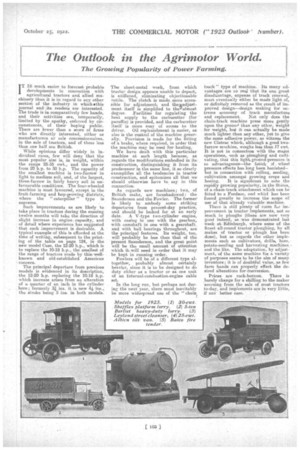The Outlook in the Agrimolor World.
Page 33

If you've noticed an error in this article please click here to report it so we can fix it.
The Growing Popularity of Power Farming.
IT IS much easier to forecast. probable developments in connection with agricultural tractors and allied machinery than, it is in regard to any other section of the industry in which athis journal and its readers are interested. The trade is in comparatively few hands, and their activities are., temporarily, limited by the apathy, enforced by circumstances, of their buying public. There are fewer than a score of firms who are directly interested, either as manufacturers or sole concesaionnaires, in the sale of tractors, and of these less than one half are British.
While opinions differ widely in individual cases, few will deny that the most popular size is, in weight, within the range 25-35 cwt., and the power from 20 h.p. to 30 h.p. The capacity of the smallest machine is two-furrow in light to medium soil, and, of the largest, three-furrow in fairly heavy soil in unfavourable conditions. The four-wheeled machine is most favoured, except in the fruit.farming and hop-growing districts, where the "caterpillar " type is supreme.
Such improvements as are likely to take place in tractors during the ensuing twelve months will take the direction of slight increase in engine, capacity, and of detail where experience has suggested that such improvement is desirable. A typical example of this is afforded at the time of writing, subsequent to the printing of the table on page 124, in the new model Case, the 12-20 h.p., which is to replace the 10-18 h.p., the smallest of the range of tractors made by this-wellknown and old-established American Concern.
The principal departure from previous models is evidenced in its description, the 12-20 h.p. replacing the 10-18 h.p. which increase arises from an alteration of a quarter of an inch in the cylinder bore; formerly 3-1 ins, it is now 41 the stroke being 5 ins, in both models. The sheet-metal work, from which tractor design appears unable to depart, is ratiffenecl, eliminating objectionable rattle. The clutch is made more accessible for adjustment, and thezadjuatment itself is simplified to theJaitanost degree. Facilities for regulating the heat supply to the carburetter (for paraffin) is provided, and the carburetter itself is more easy of access to the driver. 01.1 replenishment is easier, as also is the control of the machine generally. Provision is made for the fitting of a brake, where required, in order that the machine may be used for hauling.
We have dealt with this particular machine at such length because, as regards the modifications embodied in its construction, distinguishing it from its predecessor in the same line, it so clearly exemplifies all the tendencies in tractor construction, and epitomizes all that we should otherwise have to say in this connection.
As regards new machines; two, of British make, are foreshadowed : the Saunderson and the Fowler. The former is likely to embody some striking departures from present-day practice, and should be looked for at an early date. A V-type two-cylinder engine, with casing in one with the gearbox, with camshaft in one with a gearshaft, and with ball bearings throughout, are the principal features. Its weight, too, will probably be less than that of the present Saamderson, arid the great point will be the small amount of attention which it will need in order that it may be kept in running order.
Fowlers will be of a different type altogethec, probably almost certainly heavier, since it is to be designed to do duty either as a tractor or as one unit of an internal-combustion-engine cable set.
In the long run, but perhaps not daring, the next year, there must inevitably be more widespread use of the "chain
txack " type of machine. Its many advantages are so ma/ that its one great disad:aantage, expense of track renewal, must eventually either be ma.de light of, or definitely removed as the result of improved design—design making for en.trerne economy of track manufacture and replacement. Not only does the chain-track machine press more gently upon the grounr1 than any other, *eight for weight, bit it can actually he made much lighter than any other, yet to give the same adhesive power, as witness the new Cletrac which, although a good two. furrow nmehine, weighs less than J7 cwt. It is not in connection with the rria.iot operations, such as ploughing and cultivating, that this light ground-pressure is so advantageous—the fetish a . wheel . pressure effects ha a long been banished— but in connection with rolling, seeding, cultivation amongst growing crops and hoeing. It is significant to note the rapidly growing popularity, in the States, of a chain-track attachment which can he fitted to a Fordaon, and whicl has been found greatly to increase the scope Of use of that already valuable machine.
There is still plenty of room for ins-. movement in tractor Implements, not so much in ploughs (these are now very good indeed, as: was demonstrated last week at Bdinburgh, where some of the finest all-round tractor ploughing, by all makes of tractor or plough has been done), but as regards the other implements such as cultivators, drills, hoes, potato-seeding and harvesting machines/ and the like. The adaptation, by adjustment, of the same triad-One for a variety of purposes seems to be the aim of many inventors; it is of doubtful value, as few farm hands can properly effect the desired alterations for conversion.
Prices are rock-bottom. There is barely change for a shilling to the maker accruing from the sale of most tractors to-day, and implements are in very little, if any better case.






















































